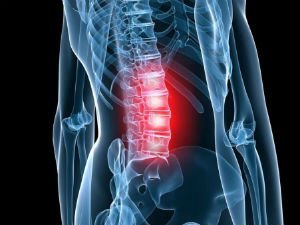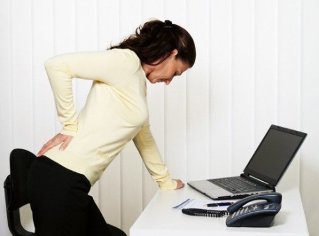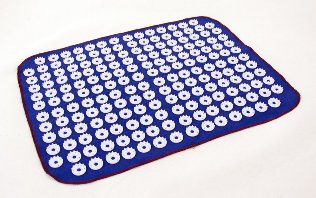
According to medical statistics, lower back pain in 80% of cases is caused by lumbar osteochondrosis. This occurs as a result of degenerative-dystrophic changes in this segment, when the intervertebral discs and adjacent vertebrae are affected. Osteochondrosis of the lumbar spine (OBOP) manifests itself in a variety of symptoms: pain with different properties, movement limitations, decreased sensitivity of the lower body, and others. In the absence of prolonged treatment, the degenerative process spreads to the vertebrae, reducing the ability to work, then the patient may become disabled.
To avoid the complications of lumbar osteochondrosis (LP), you need to start complex treatment at 1-2 stages of pathology. In advanced cases, when there are irreversible changes in the disc or spine, surgery is performed. To prevent osteochondrosis of the lower back, and related complications, prevention should be done.
Development of lumbar osteochondrosis
To understand what Lumbar Spine osteochondrosis (Lumbar Spine) is, you need to study the structure of the spinal space. It consists of vertebrae, among which are placed cartilaginous pads (intervertebral discs). The disc is covered with a hard fibrous membrane (annulus fibrosus), inside which is the nucleus pulposus. This structure has the function of absorbing shock and making the spine more flexible.
Help. The lumbar segment of the spine experiences tremendous stress every day, as it can support the upper body. Thus, osteochondrosis of the lower spine is diagnosed more often than the cervix, thorax.
With normal pressure on the spine, the disc shrinks, loses a lot of fluid, decreases in height, and the distance between vertebrae decreases. The cartilage layer becomes brittle, microclimate appears on its surface, where the nucleus pulposus protrudes over time. With further compression of the intervertebral disc, the outer shell ruptures and the body of agar falls, forming a hernia. Then there is the pathological movement of the vertebrae, the load on the adjacent segments of the spine increases.
Soon, bone growth (osteophytes) begins to form on the edges of the vertebral body. Therefore, the body tries to stabilize the spine.
Doctors distinguish 4 stages of lumbar spine osteochondrosis:
- 1 degree - problems with the disc begin, the middle part is dehydrated, it is flat, cracks appear on the outer shell. Has an off current.
- Grade 2 - the lining of the cartilage, the vertebrae move closer to each other, becoming easier to move, muscles and ligaments around the spine loosen. The pain appeared.
- 3 degrees - vertebral protrusion, hernia, and subluxation formed. Increased pain, limited movement, lower extremity sensitivity.
- Grade 4 osteochondrosis is characterized by the appearance of osteophytes, which can damage the spinal cord and adjacent vertebrae. There is persistent pain, severe neurological disorders and other complications, and the risk of disability increases.
The easiest way to cure lower back chondrosis (level 1), however, is very difficult to identify the disease at this stage. Grade 2 intervertebral osteochondrosis is treated using conservative techniques. Surgery may be needed at stages 3-4.
Help. According to statistics, OBO is more frequently detected in patients after 30 years. There are many cases of pathological development in people after 20 years. About 80% of patients over the age of 60 suffer from the manifestations of this disease.
Reason
To understand how to deal with osteopondrosis PKOP (lumbosacral spine), you need to know the cause:
- Normal static or dynamic load on the lumbar segment. Risk groups for developing osteochondrosis include office workers, professional athletes (weightlifting), movers, developers, etc.
- Poor posture, prolonged inappropriate posture.
- Genetic predisposition, abnormalities in the formation of the vertebral body. This category includes longevity software - spinal curvature caused by vertebral body pathology.
- Spinal cord injury.
- Hormonal imbalances, metabolic disorders, diseases of the endocrine glands that interfere with metabolism in the lumbar segment.
- Age-related changes in the body give rise to disc wear.
- Bone tuberculosis, osteomyelitis (purulent inflammation of bone tissue), ankylosing spondylitis (inflammation of the spine and joints), rheumatoid arthritis, etc.
Illness is often caused by a number of factors.
In addition, there are factors that provoke the development of lumbar osteochondrosis:
- Overweight.
- Passive lifestyle, long sitting.
- Regular consumption of unhealthy foods (fatty, fried foods, sweets, semi-finished products, etc. ).
- Lack of fluid, dehydration.
- Congenital disorders of spinal structure, e. g. , extra vertebrae.
- Usually wearing uncomfortable heels.
- During pregnancy, the load on the spinal cord increases.
- A sudden refusal to train professional athletes or excessive sports on people who have previously lived a passive lifestyle.
- Smoking, drinking frequently and excessively.
There are many other factors that can trigger degenerative-dystrophic processes in the lumbar spine. For example, flat feet, back hypothermia, frequent stress, sleep disturbances etc.

Symptoms
Symptoms of lumbar spine osteochondrosis are varied, it depends on the degree of pathology and localization of the affected area.
Doctors distinguish reflex syndrome and compression (symptom complex) in OBOR. The first arises when receptors of the outer membranes of the disc, ligaments, joint capsules are irritated, and the latter, when the ligaments, blood vessels, and spinal cord are compressed.
There is a reflex syndrome such as lumbar osteochondrosis:
- Lumbago. Pain shooting in the lower back with sudden movement or exercise. On the slightest attempt to move, the pain syndrome increases, until the patient freezes in one position. The muscles in the damaged area are very tense, with palpation, the painful sensation becomes more pronounced. This manifestation is associated with the movement of the nucleus pulposus inside the outer shell.
- Lumbodynia. The excruciating pain develops over several hours or days. Discomfort increases with movement, changes in body position. It is weak when one takes a horizontal posture with a roller under the lower back. While lifting the legs straight in this position, the pain increases (Lassegh symptoms). The level of muscle tension is less compared to lumbago. Lower back mobility is limited.
- Lumboischialgia. Painful sensations (sharp or sore) spread from the lower back to the lower body. There is an increase in this sign during movement. The pain is relieved by resting on the back. Muscles in the affected area are tense, pain syndrome becomes noticeable on palpation.
Symptoms of compression syndrome depend on which part of the lumbar segment is damaged. Characteristic signs are associated with compression of the spinal nerves by hernias, osteophytes, displaced vertebrae. This condition is called radiculopathy, in which pain increases with slight movement, tense lower back muscles, and limited movement.
Clinical manifestations of compression syndrome depend on damaged vertebrae in the lumbar segment:
- L1 - L3 - pain and numbness in the lumbar region, front and inner thighs, patients have difficulty bending / bending the legs at the knees.
- L4 - pain syndrome extends to the front of the thigh, down to the knee (back). In the same area, sensitivity is disturbed.
- L5 - a painful sensation radiating to the buttocks, the outside of the thighs, down along the front of the lower leg to the inside of the foot and toes. In the same area, numbness is felt, making it difficult for the patient to bend the toes.
- S1 - pain spreads from the lower back to the buttocks, the outside and back of the thighs, down to the outside of the lower legs, legs. In the same area, numbness is felt, the muscles of the lower leg become weak, making it difficult for the patient to stand on his toes.
There is a risk of damage to several groups of nerves at once, for example, L5, S1. If the hernia moves backwards, it can compress the spinal cord.
Compression of blood vessels in the lower back increases the likelihood of leg muscle weakness, numbness in the lower leg, poor control of the process of urination and defecation. In men with OBO, erections are impaired, and in women, the main symptoms may be augmented by inflammation of the ovaries or uterus.
Diagnostic measures
To diagnose OBO, the doctor examines the patient, throbs the patient to determine the condition of the muscles and identifies the curvature of the spine. It is important to tell the specialist in detail about your symptoms to make it easier for him or her to make a diagnosis.
Instrumental examination will help detect intervertebral osteochondrosis:
- X-ray of lower back (frontal and lateral projections).
- Magnetic resonance imaging and calculated.
X-rays allow you to evaluate the structure of an EPP. To detect abnormal vertebral movements, x-rays were taken in bending and extension positions. This study allows us to see that the intervertebral fissure has narrowed, the vertebral body has shifted, and the osteophyte has appeared on its edge. However, this diagnostic method is considered obsolete.
Today, CT and MRI are increasingly being used to detect degenerative-dystrophic changes in the spine. This highly informative study makes it possible to assess the condition of the spine, disc, intervertebral foramina, and spinal cord. With their help, protrusion, hernia direction, compression level of nerve groups, spinal cord, and blood vessels are detected.
Treatment
MEDICINE FOR OSTEOCHONDROSIS LUMBAR

EPP treatment of osteochondrosis lasts from 1-3 months to 1 year. The success of therapy depends on the patient himself, who must strictly adhere to the doctor's recommendations. With self-treatment, the patient's condition usually worsens.
Treatment goals:
- Stop or reduce software symptoms.
- Identify the cause of this disease, try to exclude it from life.
- Eliminates inflammatory processes.
- Restores blood circulation, metabolic processes in the lumbar spine.
- Try to repair the condition of the damaged cartilage layer, stop further degenerative changes.
To achieve this goal, it is recommended to carry out complex therapy. Usually starts with taking medication:
- Relax the muscles. They relax muscles, relieve pain and inflammation.
- NSAID. They have anti-inflammatory, analgesic, antipyretic effects.
- Antispasmodik. They help stop smooth muscle spasms, relieve pain.
- Anesthetics. They are used for severe pain syndrome in the form of therapeutic restrictions.
- Glucocorticosteroids. They also help relieve pain. However, these drugs can destroy bones, so they are taken in a short time and only after obtaining the consent of a doctor.
- Calm down. They relieve neuromuscular tension, improve sleep.
- Vitamins (groups B, E, C, A). Restores the affected nerve state, relieves pain.
Be careful. NSAIDs should not be taken for gastritis or stomach ulcers, as they damage the mucous membranes of the gastrointestinal tract.
In case of exacerbation, the patient is given an injection, and after relieving the main symptoms, he takes oral medication.
In addition, external agents are used (gels, ointments, creams, scrubs).
The question of what to do if chronic lower back osteochondrosis is relevant enough. If OBOP becomes chronic, then after eliminating the main symptoms, patients are prescribed chondroprotectors, drugs that restore blood circulation, drugs based on vitamin B. They help restore the delivery process, normalize blood supply in the affected area, and prevent the development of pathology morecontinued.
Treatment of lumbar spine chondrosis (stage 1) is done with the use of chondroprotectors, which slow down the development of degenerative processes, accelerate cartilage regrowth. In addition, patients are given vitamin and mineral complexes. This form of osteochondrosis is the easiest to cure.
OTHER CONSERVATIVE TECHNIQUES
If the acute chronic disease (osteochondrosis) is 1 - 2 degrees, the following treatment procedures will help stop its development:
- Ultrasound therapy relieves pain and inflammation, and normalizes blood flow to the damaged area.
- Detensor therapy is a safe spine attraction due to one's own weight, after which muscle tone normalizes, and mobility improves.
- Magnetotherapy reduces pain and inflammation of the muscles around the spine.
- Reflexology (inserting a needle into a bioactive point in the body) speeds up blood circulation, relieves inflammation and edema.
- Manual therapy (effects on the affected area with a doctor's hand) and massage normalize muscle tone, reduce nerve network compression, improve intervertebral disc nutrition, and restore spinal structure.
- Electrophoresis allows the delivery of drug solutions through the skin to bone and cartilage tissue.
- Drasonvalization improves blood circulation, metabolic processes, reduces pain, restores skin sensitivity.
There are many more effective procedures that will help improve the patient's condition in 5-15 sessions. The main thing is to get the doctor's consent before performing it.
HOME TREATMENT TREATMENT
If you are wondering if it is possible to treat OBO at home, talk to your doctor. If the specialist has given permission, start therapy, which usually consists of the following:
- Diet. If lumbar osteochondrosis is caused by impaired blood flow or metabolism, then exclude fatty, fried, spicy, egg, etc. from the menu. Fill the menu with fresh vegetables, fruits, lean meats, fish, and dairy products. Leave alcohol, tonic drinks (tea, coffee). Drink filtered water, compote, herbal tea.
- To restore blood circulation, exercise or apply and rub.
- Sleep on an orthopedic mattress, low pillow. If you have an inactive job, buy a chair with a back that will support your spine. Wear a special corset or belt from time to time.
- Exercise therapy will help strengthen the muscular corset, relieving some of the load from the diseased spine. The complex for each patient is arranged individually by a doctor or instructor.
- Massage the lumbar region yourself. However, ask a professional how to do it right.
- Use traditional medicine in the form of scrubs, compresses, baths, etc.
- A needle applicator is a plastic plate with lots of thorns, which improves blood circulation, metabolic processes in damaged areas, reduces muscle pain, and relieves.

And also at home you can use lotions with herbal ingredients, plaster.
Help. The new thing in the treatment of osteochondrosis is a massage bed, which is suitable even for the most irregular patients.
However, remember that home treatment can only be done with your doctor's permission.
SURGICAL TREATMENT
Surgery for lumbar osteochondrosis is prescribed if conservative techniques are proven to be ineffective for a long time. And also surgical interventions are indicated for defecation, defecation and cauda equina syndrome (pinching of the lower spinal cord).
The following surgical methods are used in the treatment of OBO:
- Spondylodesis - fusion of adjacent vertebrae.
- Facetextomy - removal of an intervertebral joint that pinches the spinal cord.
- Laminectomy is the removal of laminate that closes the spinal canal that compresses the spinal cord.
- Discectomy is the complete or partial removal of an intervertebral disc that causes compression of the nerve root or spinal cord.
- Corpectomy - removal of the vertebral body and adjacent cartilage. Then the empty space is filled with bone grafting and 3 vertebral segments merge.
Help. After surgery, there is a risk of complications: spinal cord injury, nerve entrapment, fracture grip, infection, etc.
After treatment, you need to undergo recovery to speed up your recovery.
Complications
Without proper therapy, the risk of complications of lumbar osteochondrosis like this increases:
- Herniated discs, pinched nerve roots or spinal cord.
- Prolonged inflammation increases the likelihood of developing radiculitis (inflammation of the nerve roots).
- Sciatica (inflammation of the sciatic nerve), in which there is severe pain and numbness in the lower limbs.
- If blood circulation is disturbed in the spinal cord, the likelihood of compression myelopathy increases (compression of the spinal cord by various formations: bone fragments, hernias, tumors, hematomas).
- Cauda equina syndrome - compression of the lower spinal cord, which causes dysfunction of the intestines, pelvic organs, and lower limbs.
To avoid such complications, you should start treatment as early as possible.
Prevention
To prevent lumbar osteochondrosis, follow these rules:
- Follow a fairly active lifestyle (walk more often, exercise more, sign up for a swimming pool).
- For inactive work, heat every 1. 5 hours.
- Sleep on an orthopedic mattress.
- Avoid excessive physical exercise, lift weights only from a half-squat position, before that, wear a special belt on your lower back.
- Buy orthopedic shoes.
- Eat right, take vitamin and mineral complexes as prescribed by your doctor.
- Learn to relax.
- Try not to be hypothermic.
- Treat diseases that can cause OBO in time.
- Get rid of bad habits.
By following these recommendations, you can prevent degenerative changes in the spine and improve your health.
Most Important
If you notice symptoms of lumbar osteochondrosis, see a doctor right away. Self-medication can worsen your condition and cause complications. Lumbar chondrosis (stage 1) is treated with exercise therapy, physiotherapy and chondroprotectors. At a later stage, medications, massage, manual therapy, etc. are used. If there are no positive dynamics for a long time or the onset of neurological symptoms, the doctor may prescribe surgery. Patients must adhere to the doctor's recommendations strictly to speed recovery.





































